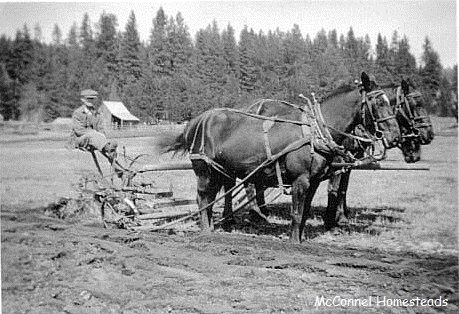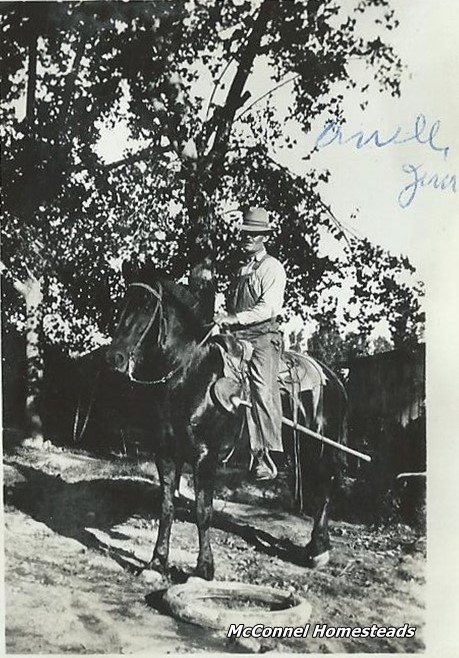
James McConnel and Idella Wheeler McConnel
Jim was born on McConnel Island, near Parma, Idaho. He attended the Dixie School. It was there that he met Susie Idella (Ida) Wheeler, whom he later married in 1907. (see quilt story) Before their marriage Susie Idella helped her oldest sister, Nora Maude Wheeler Wright at the ferry known as Froman's Ferry. The ferry crossed Snake River near the area later known as Homedale. Froman's Ferry was purchased by Nora Maude's husband, James Wright just after the turn of the century, about 1902. He was assisted in its operation by Jacob J. (Jake) Billingsley. Jim Wright was accidentally killed in 1904. Nora Maude continued the operation with Jake Billingsley's help, and eventually married him in 1908. A bridge was built in 1921 and while the ferry operation was discontinued, the farm was maintained. One of Maude's children, Laura Wright, married Frank Hubler. Laura and her brothers and sisters inherited the property. Laura and Frank purchased the shares of her siblings and the ferry and farm property remained in their care until it was sold about 1950. "My Beloved Sunny Slope" by Pearl Kirk, a history of this area, includes photographs of the ferry.
The US 1900 Census shows Jim, his parents and siblings living with his older brother Walter in High Valley. He worked on Walter's cattle ranch all the while he lived there. On December 31, 1907, James E. McConnel and Susie Idella Wheeler were married in Caldwell. The young couple's first home was in High Valley. Jim received the patent on his homestead November 1912. The US 1910 Census shows him as head of the household (age 26) living in Upper Squaw Creek (High Valley) and the household included his 24-year-old wife, Ida, his nearly one-year-old, Paul, and his 28-year-old brother, Roy. Their second child, Pearl, was born in September 1910.

Jim plowing in High Valley
Shortly after their third child, Ben, was born in January 1913 they left the High Valley ranch when they purchased a general store in Roseberry. Forest was born in 1914. He remembers the time (probably when about 3 years old) when he and Ben discovered an unattended cheese block - they ate enough that they were sick. In 1917, a stillborn child, Oliver, convinced Jim and Ida that they should take the advice of their doctor and move. Roseberry's altitude was too high for Ida's lungs and heart. They sold the store in late 1917 or early 1918 and purchased a farm in Arena Valley, not far from Parma, ID. June was born in the summer of 1918. They farmed and, in addition, Jim became an employee of the US Bureau of Reclamation, Wilder branch, in about 1921. Lois was born in 1922 while they lived on the Wilder, ID "Bench" - the area also called "Fargo Drop". In about 1924 Jim was transferred to the Lake Lowell area near Caldwell, ID then transferred back to the Wilder branch in 1925. They moved back to the Arena Valley farm not long before their last child, Earnest (Ernest) was born in 1925. In all the moves, they made sure their children attended the various schools located nearby.

Uncle Jim, note shovel in scabbard
Jim was a "ditch rider" while with the Bureau of Reclamation until shortly before his death in 1934. A ditch rider is responsible for delivering water to farmers, reading the weirs and adjusting the gates to insure the irrigation water is delivered in accordance with the request of the farmers on his route. When water was out of the irrigation canals (fall and winter) he performed other duties relating to keeping the ditches in good working order. While having the farm in Arena Valley, farming was done with the help of his wife and family until 1928 and a move to Wilder, ID. Grade and High Schools were within walking distance and all of the children attended there, while Jim continued on with his Reclamation duties.
Jim was a talented mathematician and utilized that skill in many ways. As an example, he could look at a tall tree and estimate how much lumber was obtainable. He handled and taught animals in a caring way. A gentle and kind man, he taught his family to emulate his way of life. He trained horses and dogs that made the result valuable to other people. Farming involved equipment that he maintained in excellent condition. Horses, cows, goats, pigs, chickens, and pigeons were all a part of farm life. Forest remembers using horses for plowing, cultivating, harvesting crops as well as driving them at the derrick for stacking hay. Orchards, berry bushes and a vegetable garden helped to provide food for the table and Jim was proficient in butchering calves, pigs and hogs for meat. (He taught Forest to butcher and he used the training while in Alaska.)
Jim was an adventurous person in learning new ideas and purchased a car in 1920 to the astonishment and disapproval of his father, Benjamin C., and his brothers. They observed that the car was dangerous - and horses are good enough for travel! However, not long after he had the car, his brothers decided it was an advantage and were buying them, too. One new innovation he tried was not successful. Two of Jim's brothers had surgery to remove cancerous growth on their lips. Their lips were badly disfigured as a result. When Jim sustained an injury that appeared to be cancerous, he and Ida researched procedures that could be effective without surgery. Papers written about successful treatments by X-ray convinced Jim and Ida that the new procedure was worth a try. Treatments were in Ontario, OR. It was a series of X-ray exposures with less and less in each succeeding treatment. I was twelve and observed his lip before the last treatment he had. The injury on his lip was hardly discernable, so the treatments were working. However, at his last treatment, the X-ray Technician was careless in reviewing his file and gave him a full dose. As a result, he had a severe facial X-ray burn. As soon as possible, he and Ida made a train trip to Mayo Clinic in Rochester, MN, in an effort to save his life. There was nothing that could be done, and in a matter of weeks, he died in October at the age of 51.
About two months before his death, Jim realized he would soon be unable to perform the duties of his ditch ride so he took two of his sons, Ben and Forest, around on the route to instruct them so they could take take his place and both did so individually. Jim's early death left Idella with an 8-year-old son and two older girls at home. Forest left college and Ben changed his occupation to help her financially. After his death, Ben (21) took over the ditch ride alone and Forest (19) found local work.
Note: Two of Jim's older brothers also worked for the Bureau of Reclamation, "bringing water to the west," at the Milner Dam on the Snake River. Will was the superintendent for years. Harlan was the assistant superintendent and "was killed instantly when the handle of a windlass with which he was lowering a headgate slipped from his grasp and crushed his skull."
Cultivators of the earth are the most valuable citizens. - Thomas Jefferson